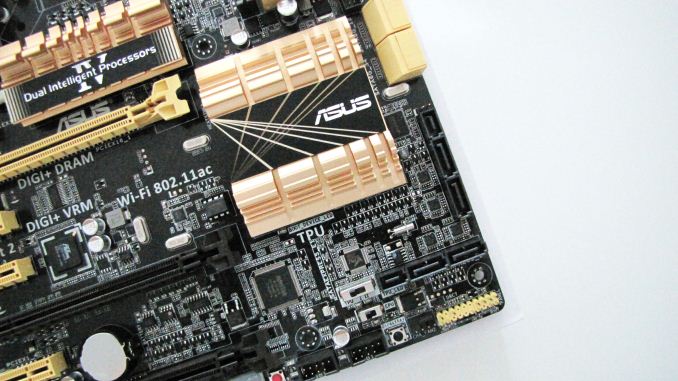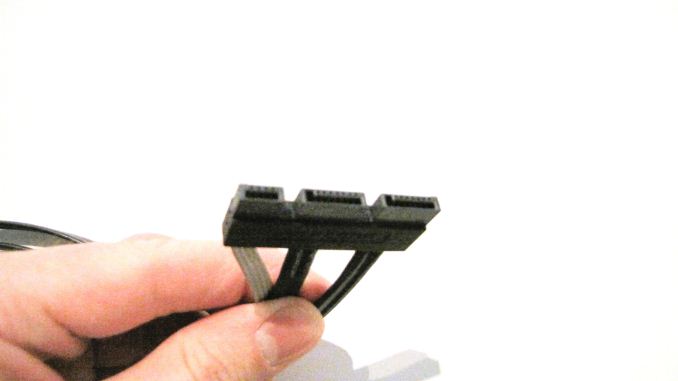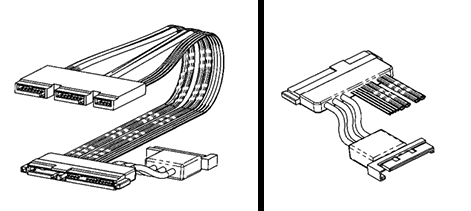Testing SATA Express And Why We Need Faster SSDs
by Kristian Vättö on March 13, 2014 7:00 AM EST- Posted in
- Storage
- SSDs
- Asus
- SATA
- SATA Express
What Is SATA Express?
Officially SATA Express (SATAe from now on) is part of the SATA 3.2 standard. It's not a new command or signaling protocol but merely a specification for a connector that combines both traditional SATA and PCIe signals into one simple connector. As a result SATAe is fully compatible with all existing SATA drives and cables and the only real difference is that the same connector (although not the same SATA cable) can be used with PCIe SSDs.
As SATAe is just a different connector for PCIe, it supports both the PCIe 2.0 and 3.0 standards. I believe most solutions will rely on PCH PCIe lanes for SATAe (like the ASUS board we have), so until Intel upgrades the PCH PCIe to 3.0, SATAe will be limited to ~780MB/s. It's of course possible for motherboard OEMs to route the PCIe for SATAe from the CPU, enabling 3.0 speeds and up to ~1560MB/s of bandwidth, but obviously the PCIe interface of the SSD needs to be 3.0 as well. The SandForce, Marvell, and Samsung designs are all 2.0 but at least OCZ is working on a 3.0 controller that is scheduled for next year.
The board ASUS sent us has two SATAe ports as you can see in the image above. This is a similar port that you should find in a final product once SATAe starts shipping. Notice that the motherboard connector is basically just two SATA ports and a small additional connector—the SATA ports work normally when using a standard SATA cable. It's only when the connector meets the special SATAe cable that PCIe magic starts happening.
ASUS mentioned that the cable is not a final design and may change before retail availability. I suspect we'll see one larger cable instead of three separate ones for esthetic and cable management reasons. As there are no SATAe drives available yet, our cable has the same connector on both ends and the connection to a PCIe drive is provided with the help of a separate SATAe daughterboard. In the final design the other end of the cable will be similar to the current SATA layout (data+power), so it will plug straight into a drive.
That looks like the female part to the SATA connector in your SSD, doesn't it?
Unlike regular PCIe, SATAe does not provide power. This was a surprise for me because I expected SATAe to fully comply with the PCIe spec, which provides up to 25W for x2 and x4 devices. I'm guessing the cable assembly would have become too expensive with the inclusion of power and not all SATA-IO members are happy even with the current SATAe pricing (about $1 in bulk per cable compared to $0.30 for normal SATA cables). As a result, SATAe drives will still source their power straight from the power supply. The SATAe connector is already quite large (about the same size as SATA data + power), so instead of a separate power connector we'll likely see something that looks like this:
In other words, the SATAe cable has a power input, which can be either 15-pin SATA or molex depending on the vendor. The above is just SATA-IO's example/suggestion—they haven't actually made any standard for the power implementation and hence we may see some creative workarounds from OEMs.















131 Comments
View All Comments
Kristian Vättö - Tuesday, March 18, 2014 - link
Bear in mind that SATA-IO is not just some random organization that does standards for fun - it consists of all the players in the storage industry. The current board has members from Intel, Marvell, HP, Dell, SanDisk etc...BMNify - Thursday, March 20, 2014 - link
indeed, and yet its now clear these and the other design by committee organization's are no longer fit for purpose , producing far to little far to late....ARM IP =the generic current CoreLink CCN-508 that can deliver up to 1.6 terabits of sustained usable system bandwidth per second with a peak bandwidth of 2 terabits per second (256 GigaBytes/s) at processor speeds scaling all the way up to 32 processor cores total.
Intel IP QPI = Intel's Knights Landing Xeon Phi due in 2015 with its antiquated QPI interconnect and its expected ultra short-reach (USR) interconnection only up to 500MB/s data throughput seems a little/lot short on real data throughput by then...
Hrel - Monday, March 17, 2014 - link
Cost: Currently PCI-E SSD's are inexplicably expensive. If this is gonna be the same way it won't sell no matter how many PCI-E lanes Intel builds into it's chipset. My main concern with using the PCI-E bus is cost. Can someone explain WHY those cost so much more? Is it just the niche market or is there an actual legitimate reason for it? Like, PCI-E controllers are THAT much harder to create than SATA ones?I doubt that's the case very much. If it is then I guess prices will drop as that gets easier but for now they've priced themselves out of competition.
Why would I buy a 256GB SSD on PCI-E for $700 when I can buy a 256GB SSD on SATA for $120? That shit makes absolutely no sense. I could see like a 10-30% price premium, no more.
BMNify - Tuesday, March 18, 2014 - link
"Can someone explain WHY those cost so much more?"greed...
due mostly to not invented here is the reason we are not yet using a version of everspin's MRAM 240 pin, 64MByte DIMM with x72 configuration with ECC for instance http://www.everspin.com/image-library/Everspin_Spi...
it can be packaged for any of the above forms M2 etc too rathe than have motherboard vendors put extra ddr3 ram slots decicated to this ddr3 slot compatable everspin MRAM today with the needed extra ddr3 ram controllers included in any CPU/SoC....
rather than licence this existing (for 5 years ) commercial MRAM product and collaborate together to make and improve the yield and help them shrink it down to 45nm to get it below all of today's dram fastest speeds etc they all want an invented here product and will make the world markets wait for no good reason...
Kristian Vättö - Tuesday, March 18, 2014 - link
Because most PCIe SSDs (the Plextor M6e being an exception) are just two or four SATA SSDs sitting behind a SATA to PCIe bridge. There is added cost from the bridge chip other additional controller, although the main reason are the laws of economics. Retail PCIe SSDs are low volume because SATA is still the dominant interface and that increases production costs for the OEMs. Low order quantities are also more expensive for the retailers.In short, OEMs are just trying to milk enthusiasts with PCIe drives but ones we'll see PCIe entering the mainstream market, you'll no longer have to pay extra for them (e.g. SF3700 combines SATA and PCIe in a single chip, so PCIe isn't more expensive with it).
Ammohunt - Thursday, March 20, 2014 - link
Disappointed there wasn't a SAS offering compared 6GB SAS != 6G SATAjseauve - Thursday, March 20, 2014 - link
Awesome computerwestfault - Saturday, March 22, 2014 - link
"The SandForce, Marvell, and Samsung designs are all 2.0 but at least OCZ is working on a 3.0 controller that is scheduled for next year."When you say OCZ is developing on a PCIe 3.0 controller do you mean that they were working on one before they were purchased by Toshiba, or was this announced since they were acquired by Toshiba? I understand that Toshiba has kept the OCZ name, but is it certain that they have continued all R&D from before OCZ's bankruptcy?
dabotsonline - Monday, April 28, 2014 - link
Roll on SATAe with PCIe 4.0, let alone 3.0 next year!MRFS - Tuesday, January 20, 2015 - link
I've felt the same way about SATAe and PCIe SSDs --cludgy and expensive, respectively.
Given the roadmaps for PCIe 3.0 and 4.0, it makes sense to me, imho,
to "sync" SATA and SAS storage with 8G and 16G transmission clocks
and the 128b/130b "jumbo frame" now implemented in the PCIe 3.0 standard.
Ideally, end users will have a choice of clock speeds, perhaps with pre-sets:
6G, 8G, 12G and 16G.
In actual practice now, USB 3.1 uses a 10G clock and 128b/132b jumbo frame:
max headroom = 10G / 8.25 bits per byte = 1.212 GB/second.
132 bits / 16 bytes = 8.25 bits per byte, using the USB 3.1 jumbo frame
To save a lot of PCIe motherboards, which are designed for expansion,
PCIe 2.0 and 3.0 expansion slots can be populated with cards
which implement 8G clocks and 128b/130b jumbo frames.
That one evolutionary change should put pressure on SSD manufacturers
to offer SSDs with support for both features.
Why "SATA-IV" does not already sync with PCIe 3.0 is anybody's guess.
We tried to discuss this with the SATA-IO folks may moons ago,
but they were quite committed to their new SATAe connector. UGH!